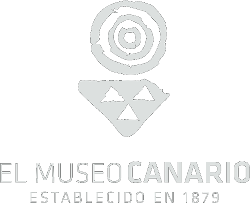A product of the work of mud are two elements that are exposed in this room and that bring us closer to the life forms of the canaries: the painters and the idols.
The pintaderas are pieces mostly made of clay, composed of a more or less flat base and a handle or appendage that in some cases was drilled through a hole. The base can be square, rectangular, circular, triangular, rhomboid, etc. and is provided with geometric decorative motifs, made with printing, incision and excision techniques, which occupy the entire surface or part of it.
The interpretations that had sought to explain the development of these materials have revolved around two issues. On the one hand, some authors claim that they must have been intended for body decoration by its impregnation in almagre and subsequent print on the skin. Other authors, from ethnoarcheological comparisons with North African populations – an area in which they are used to mark the different deposits of barns – propose their use as seals of personal identification.
The other elements that bring us closer to the culture of the ancient canaries are idols. These are anthropomorphic figures, zoomorfas and other representations of difficult adscription, made mostly in cooked clay, and whose characteristics allow to include them among the manifestations of the world of Aboriginal beliefs.
Many of the ritual practices described by documentary sources, as well as certain archaeological evidence, appear to be aimed at fostering fertility. Examples of this are some of the magical-religious ceremonies that describe the chronicles of the conquest, the cave engravings of inverted triangles interpreted as pubic triangles – documented in various areas of the island such as the Cave of the Candiles (Artenara), depicted in the room – and also a good part of the idols.
Indeed, some of the exposed human figures have explicitly marked sexual attributes, traits that lead to linking them with a certain form of fertility and propitiation.
A reproduction of the Painted Cave of Gáldar is also exhibited in the room. This decorated chamber is integrated into a wider complex of artificial caves whose plant is represented in a panel also on display, which in turn is part of the village of the same name, for which almost half a hundred stone houses have been counted. In three of the walls of this cave are observed paintings formed by geometric figures for whose execution the colors red and white were used, while taking advantage of the dark tone of the support itself.

